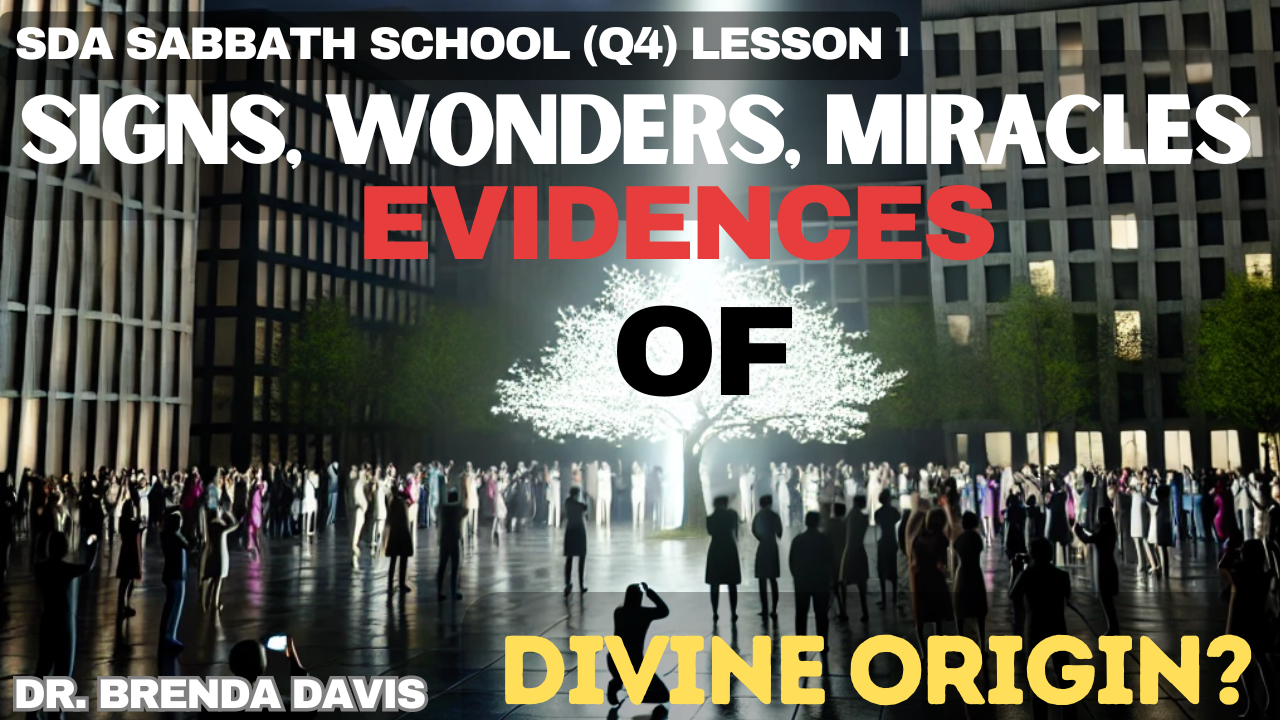The Gospel of John (Lesson 1) Signs That Point the Way
SIGNS, WONDERS, AND MIRACLES EVIDENCE OF DIVINE ORIGIN?
“Signs, wonders, and miracles are sure ways to capture our attention.
Throughout the Bible, we see miracles performed to reveal God moving and directing his people. How do you respond to them, and how can we be sure they come from God?
Welcome to our new 13-part series. Here, we’ll explore the unique message of the Gospel of John—a book unlike the other Gospels (Matthew, Mark, and Luke). John’s Gospel is different in that it gives us an up-close look at the personal conversations Jesus had with individuals who were convinced of who He is, like Nicodemus, the woman at the well, and others. What made them so sure? These stories reveal deep truths about who Jesus is and why He is so important to us today. Stay with us throughout the entire series by subscribing to my YouTube Channel, Sabbath School Daily by DrBrenda Ware Davis, or going to my Website, SabbathSchoolDaily.com. This journey through John will help you get to know Jesus up close and person and transform your life.
As always, before we begin, let’s Pray.
Inviting God’s Presence.
Holy Father, thank you for the Gospel of John. Open our hearts and minds to receive the message you personally have for us. In Jesus’ Name, Amen!
The Gospel of John
(Lesson 1)
Signs That Point the Way
Part 1 Introduction
John wrote about Jesus doing many powerful works. He expresses that there are so many they couldn’t all be recorded in just one book.
So, why did he choose to write about specific ones? Why did he write his Gospel?
Was it his purpose to emphasize Jesus’ miracles or some specific teachings of Jesus?
What was his aim in writing the Gospel of John?
Influenced by the power of the Holy Spirit, John tells us why in John 20:30-31:
30 Jesus performed many other signs in the presence of his disciples, which are not recorded in this book.
31 But these are written that you may believe that Jesus is the Messiah, the Son of God, and that by believing you may have life in his name. (John 20:30, 31, NKJV).
Moreover, John 21:25 says,
25 And there are also many other things that Jesus did, which if they were written one by one, I suppose that even the world itself could not contain the books that would be written. Amen. (John 21:25)
Therefore, John’s goal wasn’t just to tell us what Jesus did but to inspire us to believe “that Jesus is the Christ, the Son of God, and that believing we may have life in His name.”
Looking at John’s gospel, we witness some of Jesus’ early miracles.
We see Him turning water into wine at a wedding feast; we see Him heal an official’s son and a disabled man at the Pool of Bethesda.
John calls these miracles “signs.” Signs of what?
Of course, they are not the kind of signs you see on a street corner. They are miracles performed for a special purpose.
They are designed as signs to show that Jesus is the Savior, the promised Messiah.
The book The Desire of Ages points out that.
Every miracle that Christ performed was a sign of His divinity. He was doing the very work that had been foretold of the Messiah;” (The Desire of Ages, p. 406).
In each of these stories, from John, we see examples of people who reacted in faith, and observing their actions is intended to encourage us to do the same.
The first sign identifying who Jesus is was at a wedding feast.
Why was this sign so significant? Read John 2:1-11 Then continue to Part 2: The Wedding at Cana.
The Gospel of John
(Lesson 1)
Signs That Point the Way
Part 2: The Wedding at Cana
Jesus performs His very first miracle at a wedding in Cana, documented in John 2:1–11.
At this wedding, something incredible happened that provided the evidence Jesus’ disciples needed to help them make the decision to follow Him.
At this wedding feast, Jesus turned water into wine.
No, this wasn’t just a trick to impress the guests. This was a powerful sign, but it wasn’t just about turning water into wine.
It was incredible evidence that Jesus was sent from God.
At the time, Jesus’ followers didn’t fully grasp that He was God, but this miracle pushed them toward that truth.
It showed them that Jesus was not just anyone; they recognized that something divine was at work in him.
This sign of turning water into wine pointed them to Israel’s past.
It was a reminder of Moses, the leader of the Israelites, who, according to Deuteronomy 6:22 and Deuteronomy 26:8, God used to bring the Israelites out of Egyptian slavery with many signs and wonders. So, in a sense, Moses was a kind of savior to Israel.
Jesus’ miracle with the water was a reminder of those times—specifically the first plague in Egypt in which Moses turned the Nile into blood.
Unlike the plague that brought destruction, Jesus’ turning the water brought joy and celebration.
This miracle revealed His power to bring life.
God had promised through Moses that a prophet would come who would be like Moses.
As expressed in Deuteronomy 18:15, Matthew 17:5, and Acts 7:37, God instructed Israel to hear this prophet.
That “prophet” is Jesus. This was confirmed in John 2 when Jesus performed His first miracle.
Interestingly, the water came from six pots used for purification in Jewish ceremonies, thereby linking Jesus’s miracle even more closely to God’s promise of salvation.
By recounting Jesus’s changing of the water to wine and directing our minds back to the Exodus, in which the Israelites were freed from slavery, John was pointing to Jesus as our Deliverer.
In other words, John connects this miracle to deep, historical, and spiritual roots to help us see Jesus as the ultimate Savior, the one whom Moses indicated would come.
From This Day with God, it says: When the time had fully come, the miracle wrought by Christ was recognized. As soon as the ruler of the feast put the goblet to his lips and tasted the wine, he looked up with glad surprise. The wine was superior to any he had ever before drunk. And it was unfermented wine. He said to the bridegroom, (Pause)
“Every man at the beginning doth set forth good wine; and when men have well drunk, then that which is worse: but thou hast kept the good wine until now” (verse 10).
Christ did not approach the jars, or touch the water; He simply looked upon the water, and it became the pure juice of the grape, clarified and refined. What effect did this miracle have?—“His disciples believed on him” (verse 11). . . . By this miracle Christ also gave evidence of His mercy and compassion. He showed that He had regard for the necessities of those who followed Him to hear His words of knowledge and wisdom.—This Day with God, p. 366.
An important point here is that because the wine was fresh, it was unfermented, meaning it was nonalcoholic, pure grape juice.
According to the SDA Bible Dictionary, The Greek term for wine is used both for fresh and fermented grape juice (Seventh-day Adventist Bible Dictionary, p. 1177).
Furthermore, Ellen White in The Desire of Ages states that the juice produced by the miracle was not alcoholic. The Desire of Ages “At the Marriage Feast,” p. 149). (Papuse)
In telling this story, John does two things: He reminds us of God’s past miracles with Moses in leading Israel out of slavery, and he helps us see that Jesus is our Savior, leading us not out of physical slavery but out of the bondage of sin.
Hence, Jesus’ miracles were meant to help people believe in Him. He showed His power and love in amazing ways, changing lives wherever He went.
But the real question is: What do these miracles teach us about who Jesus truly is?
A closer look at His miracles of healing helps us to see a deeper truth that can change our lives today. What is that deeper truth? Read: John 4:46-54.
Then, View the next segment of this video, Part 3: The Second Sign in Galilee.
The Gospel of John
(Lesson 1)
Signs That Point the Way
Part 3: The Second Sign in Galilee
John 4:46-54 starts with a nobleman, a man of high status, whose son was very sick.
The father, desperate and full of fear, traveled a long way to find Jesus.
He had heard of the miracles Jesus had done, including the one at the wedding in Cana, where Jesus turned water into wine, according to John 2:1-11.
In Capernaum, the tidings [of Christ’s return to Cana] attracted the attention of a Jewish nobleman who was an officer in the king’s service.
A son of the officer was suffering from what seemed to be an incurable disease.
Physicians had given him up to die; but when the father heard of Jesus, he determined to seek help from Him. . . .
On reaching Cana he found a crowd surrounding Jesus. With an anxious heart he pressed through to the Saviour’s presence.
His faith faltered when he saw only a plainly dressed man, dusty and worn with travel. He doubted that this Person could do what he had come to ask of Him; yet, . . . his sorrow was known to Jesus. Before the officer had left his home, the Saviour had beheld his affliction.
But He knew also that the father had, in his own mind, made conditions concerning his belief in Jesus.
Unless his petition should be granted, he would not receive Him as the Messiah. While the officer waited in an agony of suspense, Jesus said, “Except ye see signs and wonders, ye will not believe.” . . .
The Saviour contrasted this questioning unbelief with the simple faith of the Samaritans, who asked for no miracle or sign.—The Desire of Ages, pp. 196–198.
So, he believed that maybe—just maybe—Jesus could heal his son.
John, the writer of this Gospel, brings up the miracle at the wedding again to remind us that Jesus’ signs are not just about fixing problems or showing power.
They point us to something deeper: Jesus is the Son of God, and these miracles are proof of His divine nature.
When the nobleman begged Jesus to heal his son, Jesus didn’t immediately give him the answer he wanted.
Instead, He pointed out a deeper issue. Jesus said, “Unless you see signs and wonders, you will not believe” (John 4:48).
This may sound harsh, but Jesus was doing something more than healing a sick child—He was trying to heal the man’s heart.
“The nobleman had a degree of faith; for he had come to ask what seemed to him the most precious of all blessings. Jesus had a greater gift to bestow.
He desired, not only to heal the child, but to make the officer and his household sharers in the blessings of salvation, and to kindle a light in Capernaum, which was so soon to be the field of His own labors. But the nobleman must realize his need before he would desire the grace of Christ. . .
Like a flash of light, the Saviour’s words to the nobleman laid bare his heart. He saw that his motives in seeking Jesus were selfish. His vacillating faith appeared to him in its true character.
In deep distress he realized that his doubt might cost the life of his son. He knew that he was in the presence of One who could read the thoughts, and to whom all things were possible.
In an agony of supplication he cried, “Sir, come down ere my child die.” His faith took hold upon Christ as did Jacob, when, wrestling with the Angel, he cried, “I will not let Thee go, except Thou bless me.” Genesis 32:26.
Like Jacob he prevailed. The Saviour cannot withdraw from the soul that clings to Him, pleading its great need. “Go thy way,” He said; “thy son liveth.”
The nobleman left the Saviour’s presence with a peace and joy he had never known before. Not only did he believe that his son would be restored, but with strong confidence he trusted in Christ as the Redeemer.—The Desire of Ages, p. 198.
Hear what it says in the book Special Testimonies to Ministers and Workers, no. 3, p. 44
The Lord has promised to give light to those who seek him with the whole heart. If we will but wait patiently and prayerfully upon God, and not follow our own impetuous plans, he will guide our decisions, and open many doors of hope and labor. The great General of armies will lead in every battle for the advancement of his cause. He will be the guide of his people in the perilous conflicts in which they have to engage, if [they] . . . will do their appointed work, and listen to the voice which says, “This is the way, walk ye in it;” “They that follow me shall not walk in darkness.” What a great comfort this promise should be to us! We may walk in the light as he is in the light. . . . Men may follow many kinds of lights, but there is only one Light that it will be safe for them to follow. Pause
Be sure that you are following Jesus whithersoever he goeth.—Special Testimonies to Ministers and Workers, no. 3, p. 44.
You see, the nobleman only wanted Jesus to prove Himself through a miracle. But Jesus knew that true faith is more than just seeing signs and wonders.
Faith is more than seeing something amazing happen. True faith comes from trusting in who Jesus is, not just what He can do.
The nobleman’s son was sick, but the man’s soul needed healing too. He needed to trust in God, even when he had no evidence that God was leading.
Jesus knew that if our faith was only based on miracles, it wouldn’t last. Therefore, Jesus was inviting him—and us—to a faith that goes beyond seeing and experiencing signs and wonders. It’s about believing in Jesus and trusting Him even when we don’t see the bigger picture.
Finally, in John 4:50 Jesus says to the nobleman, “Go; your son will live.”
Here’s where it gets really powerful. The word Jesus used for “will live” in the original Greek is in the present tense, meaning it was as good as done right then.
Even though the nobleman couldn’t see it yet, Jesus was already at work.
What did the nobleman do next? He believed Jesus’ words without any evidence and went home. He didn’t rush back in a panic.
He trusted that what Jesus said would happen. When he got home the next day, he found out that at the exact moment Jesus spoke, his son’s fever left him. His child was healed, and his faith grew even stronger.
This story isn’t just about the physical healing of the boy. It’s about the spiritual healing of the father.
Jesus helped him see that faith is more than witnessing a miracle, sign, or wonder—it’s about believing in Jesus and trusting His word.
Sometimes, we think that seeing something amazing will make us believe in God. But the Bible teaches us that miracles alone don’t prove anything about God.
After all, Paul in 2 Thessalonians 2:9-12 tells us that even Satan can perform supernatural acts.
9 The coming of the lawless one is according to the working of Satan, with all power, signs, and lying wonders,
10 and with all unrighteous deception among those who perish, because they did not receive the love of the truth, that they might be saved.
11 And for this reason God will send them strong delusion, that they should believe the lie,
12 that they all may be condemned who did not believe the truth but had pleasure in unrighteousness. (2 Thessalonians 2:9-12)
So how can we know if a miracle is truly from God? We must look at the bigger picture—at the message and the source of the miracle.
If it points to Jesus and leads us to trust Him more, then we can be confident it’s from God.
Miracles are signs that show us who Jesus is. They invite us to trust Him, not just because of what He can do, but because of who He is—our Savior and Lord.
This story challenges us to ask: What do we believe about Jesus? Are we only looking for miracles to prove His love and power, or can we trust Him even when we don’t see immediate results?
The nobleman learned that real faith is not just about witnessing a miracle—it’s about trusting Jesus, believing His word, and knowing that He is always at work, even when we can’t see it yet.
You can have that same faith. Whether you’re waiting for a breakthrough, a healing, or an answer to your prayers, remember that Jesus is calling you to trust Him.
Miracles are powerful, but the greatest miracle is the faith that grows in our hearts when we believe in Jesus—no matter what.
The next sign that John records is at a pool called Bethesda. Why at a pool? Read John 5:1-9.
Then, Continue to the next segment of this video, Part 4: The Miracle at the Pool of Bethesda
We’ve all heard stories of miracles, signs, wonders that seem too good to be true. Where does true healing come from?
The next sign that John records is found in John 5:1-9; it takes place at a pool called Bethesda in Jerusalem. People believed that in this pool, an angel would sometimes stir up the water, and the first person to step in after the water was stirred would be healed.
Because of this belief, the area around the pool was crowded with sick or disabled people who were all hoping to be the first into the pool at the next movement of the water so that they might be healed.
Picture the sight. All these people, some severely ill and disabled, are waiting by this pool, staring at the water and hoping for a chance to get into the pool to be cured once the water is stirred. Sadly, the cure does not come.
John tells us in John 5:1-9 that among them was a man who had been unable to walk for 38 years. Like the others, he had been waiting for a long time, hoping for his chance to get into the water. But he had no one to help him, and after all those years, his hope was fading.
But, on this day, Jesus walked by the pool and saw the man lying there. Even though it was clear that the man wanted to be healed, Jesus asked him a surprising question: “Do you want to be healed?” (John 5:6).
Why did Jesus ask this question?
The man had been sick for so long that his illness had become part of who he was. Sometimes, when we’ve been struggling for a long time, it becomes hard to imagine life any other way. Even though we want change, we might be afraid of what life will look like after the change.
The man told Jesus that he couldn’t get to the pool fast enough because no one would help him.
His response indicated that he wanted healing, but his focus on the water as the source of his healing was in the wrong direction.
He did not realize that the One who could truly heal him was standing right before him.
For all of his 38 years, he had been looking for healing in the wrong place!
He did not realize that the person he was talking to, the one staring him in the face, was the only one who could bring him true healing.
Jesus does not help the man to get into the pool.
“Jesus does not ask this sufferer to exercise faith in Him. He simply says, ‘Rise, take up thy bed, and walk.’ But the man’s faith takes hold upon that word. Every nerve and muscle thrills with new life, and healthful action comes to his crippled limbs. Without question he sets his will to obey the command of Christ, and all his muscles respond to his will. Springing to his feet, he finds himself an active man. . . . Jesus had given him no assurance of divine help. The man might have stopped to doubt, and lost his one chance of healing. But he believed Christ’s word, and in acting upon it he received strength.”—Ellen G. White, The Desire of Ages, pp. 202, 203.
This man had been looking for healing in the wrong place, but when Jesus spoke, he trusted Him and acted on His words. That’s when the miracle happened.
John 5:14 says
14 Afterward Jesus found him in the temple, and said to him, “See, you have been made well. Sin no more, lest a worse thing come upon you.” (John 5:14).
You see, Jesus wasn’t just concerned with healing the man’s body; He was also concerned with the man’s soul.
While not all sickness is caused by sin, sin can lead to suffering. Jesus was telling the man to live a new life, free from sin, because spiritual sickness is far more dangerous than physical sickness.
This story teaches us that not every miracle or sign is proof that it’s from God.
True healing comes when we trust Jesus, not just the signs or wonders.
The man at the pool thought the water was his only hope, but Jesus showed him that faith in God is the real source of healing.
We might be looking for answers in the wrong places, but Jesus is standing right in front of us, offering healing and hope.
Are you willing to trust His word and take action, even before seeing the miracle?
Signs and wonders can amaze us, but real change happens when we put our faith in Jesus.
He is the one who heals, saves, and transforms lives. Let’s trust Him and let go of anything that holds us back.
The greatest sign of all is a heart that believes and acts on His word.
Although signs, wonders, and even miracles are not always necessarily from God, what is the danger, however, in rejecting them when they are of God? Read John 5:10-16
Then, continue to the next segment of this video: Part 5: Hard Hearts
The Gospel of John
(Lesson 1)
Signs That Point the Way
Part 5: Hard Hearts
Signs, wonders, and miracles can be powerful and amazing. But just because we see something miraculous, does that mean it’s always from God? Not necessarily.
In fact, sometimes, even when God is at work, people reject it. On many occasions, when Jesus performed a miracle, instead of celebrating, the religious leaders tried to stop Him.
What does that teach us about seeing the truth and recognizing God’s hand in our lives?
In John 5:10-16, we talked about the man who had been sick and unable to walk for 38 years.
Jesus healed him by the Pool of Bethesda, telling him to get up, take his mat, and walk.
The man did exactly what Jesus said and walked away, carrying his mat.
You’d think people would be amazed and thank God for such a miracle.
However, it was the Sabbath Day. So, instead of being joyful and grateful for the man’s healing, the religious leaders were upset. John 5:16 says
16 For this reason the Jews persecuted Jesus, and sought to kill Him, because He had done these things on the Sabbath. (John 5:16)
You see, Jesus had performed the miracle on the Sabbath, a day when people were supposed to rest.
Healings were allowed on the Sabbath only in an emergency. His healing could hardly be an emergency after having been disabled for 38 years. What’s more, why did he need to take up his bed?
According to their religious rules, carrying a mat was considered “work,” which wasn’t allowed on the Sabbath.
So, rather than praising God for the healing, their focus was on the fact that Jesus broke their Sabbath rules.
They were so concerned with their man-made regulations that they missed the bigger picture: God worked through Jesus to heal people.
You would think that someone with God’s power to perform such miracles would also know if it was okay to carry a mat back to their home on the Sabbath day.
Clearly, Jesus was seeking to help them understand biblical truths.
He wanted to take them beyond their man-made rules and regulations, which had often stifled true faith, and help them understand that doing good on the Sabbath is lawful.
So, when Jesus healed the man at the Pool of Bethesda, he told the leaders that Jesus had healed him, and they became even angrier. Instead of celebrating the miracle, they wanted to kill Jesus for breaking their rules.
Why were they so blind to the miracle?
The truth is that these leaders had hard hearts. They had their own ideas about what the Messiah should be like and how He should act.
They expected the Messiah to free them from the Romans, not challenge their religious traditions.
They also loved their power and didn’t want to give it up. This caused them to reject Jesus, even though He was standing right in front of them, performing miracles.
This wasn’t the only time people ignored the evidence of God’s work.
In John 9:1-16, Jesus healed a blind man, but again, the religious leaders were upset because He did it on the Sabbath.
In Mark 3:22-23 and Matthew 12:9-14, the leaders accused Jesus of using Satan’s power to perform miracles.
Over and over, they refused to see the truth, even when the proof was right in front of them.
What can we learn from this? Sometimes, people don’t want to see the truth because it challenges their beliefs or power.
No matter how clear the evidence is, their hearts remain closed.
In John 5:38-42, Jesus warned the religious leaders that they didn’t have God’s word living in their hearts. They knew the Scriptures but didn’t recognize the One the Scriptures were talking about—Jesus.
He told them they couldn’t see the truth because of their lack of love for God.
This is a powerful reminder for us today. We can know all about the Bible, go to church, and still miss what God is doing in our lives if our hearts aren’t open to Him.
If we hold onto pride, power, or false ideas, we might be blinded to the truth God wants us to see.
The point is that signs and wonders alone don’t always prove something is from God.
We must look deeper and ask if what we see leads us closer to Him.
We also need to check our own hearts. Are we open to God’s truth, or are we letting pride, power, or our own ideas blind us?
Day by day, men and women are deciding their eternal destiny… When a man will do or say anything to gain his end, nothing but the power of God can save him. His character needs to be transformed before he can have a good conscience, void of offense toward God and man. Self must die, and Christ must take possession of the soul temple. When, by rejecting the light that God has given, men abuse and trample upon the conscience, they are in fearful danger. Their future eternal welfare is danger.—Mind, Character, Personality, vol. 1, pp. 319, 320.
However, Jesus is always ready to work in our lives, but we must be ready to receive it. Let’s keep our hearts soft and open to the truth, trusting that God is always at work, even when it challenges us to change.
In spite of His opposition to healing on the Sabbath by the religious leaders, what was Jesus’ Claim? Read John 5:16-47
Then, continue to the next segment of this video, Part 6: Jesus Claims
The Gospel of John
(Lesson 1)
Signs That Point the Way
Part 6: Jesus Claims
The miracle at the Pool of Bethesda wasn’t just about healing—it was about showing who Jesus truly is.
John, the writer of the Gospel, uses this miracle to open up a bigger conversation about Jesus’ identity.
In just nine verses, John describes the healing, but then spends 40 more verses talking about the One who performed it—Jesus.
After Jesus healed the man at the Pool of Bethesda, the religious leaders were furious.
Why? because Jesus performed this miracle on the Sabbath. In their eyes, Jesus was “working” on the Sabbath, so they considered that he had broken the Sabbath. But there was more to their anger than just Sabbath breaking.
In John 5:16-18, we see that Jesus wasn’t just claiming to heal on the Sabbath—He was claiming to be equal with God.
16 For this reason the Jews persecuted Jesus, and sought to kill Him, because He had done these things on the Sabbath.
17 But Jesus answered them, “My Father has been working until now, and I have been working.”
18 Therefore the Jews sought all the more to kill Him, because He not only broke the Sabbath, but also said that God was His Father, making Himself equal with God. (John 5:16-18)
Jesus explained that just as God the Father continues His work of sustaining the world even on the Sabbath, He too was doing the work of God.
This was a bold statement, and the leaders saw it as blasphemy, a claim to divinity that they weren’t willing to accept.
After this, Jesus took the opportunity to explain who He really is, especially to the religious leaders who were accusing Him. He made His defense in three powerful steps.
- First, He Explains His Relationship with the Father (John 5:19-30):
Jesus explained that He and the Father were completely in harmony. Everything Jesus did, including healing on the Sabbath, aligned with God’s will. Jesus went further, saying that He had the power to judge people and even raise the dead. These were things that only God could do, and Jesus was making it clear that He shared this divine authority.
- Second, He calls on Four Witnesses (John 5:31-38):
Jesus called on four “witnesses” to prove His identity:
John the Baptist: John was a respected prophet who testified about Jesus (John 5:31-35).
The Miracles: Jesus pointed to His miracles as evidence that God was working through Him (John 5:36).
God the Father: Jesus said that God Himself testified to who He was (John 5:37-38).
The Scriptures: Jesus explained that the Scriptures, which the religious leaders studied so carefully, pointed to Him as the promised Messiah (John 5:39).
- Finally, He Gives A Warning to the Leaders (John 5:40-47):
Setting before them their own condemnation, Jesus confronted the religious leaders about their unbelief.
Contrasting between His ministry and their self-seeking, He told them they were so focused on their own ideas and power that they couldn’t see the truth right before them.
Jesus warned them that even Moses, the one they claimed to follow, would condemn them because they refused to believe in the One Moses wrote about, the one they set their hopes in—the Messiah.
This story serves as a warning for all of us. The religious leaders knew the Scriptures, followed the rules, and thought they were doing the right thing.
But they didn’t truly surrender to God’s will. They were more concerned with keeping their traditions and maintaining power than with accepting Jesus for who He was.
We can fall into the same trap today. We might believe in God, go to church, and follow all the right teachings, but if we don’t fully surrender our hearts to Jesus, we can miss what He is doing in our lives.
It’s not enough to know about Jesus—we must know him, trust Him completely, and follow Him, even when it challenges our own ideas.
Jesus is not just a miracle worker; He’s the Son of God, the One who has the power to save us and give us eternal life.
We can’t let our own ideas, traditions, or pride get in the way of seeing the truth about who He is.
Let’s make sure we aren’t just believing in the right things but fully surrendering our lives to Jesus, trusting in His word, and following Him every day.
You see, the greatest miracle isn’t physical healing—it’s the transformation of our hearts when we give everything to Him. Allow Jesus to perform miracles in your life. Give your life to Him, give Him your heart.
———————————————–
Thank you for sharing your time with us.
To be notified when my next video is released, Subscribe to my YouTube Channel, SabbathSchoolDaily by Dr. Brenda Ware Davis.
You may watch many of our other videos @ SabbathSchooldaily.com
The free study guide for this series is available at Sabbath.School or ssnet.org
If you enjoyed this video, click Like…..Then…..Share.
Thank you for Liking, Sharing, and Subscribing.
Hebron Seventh-day Adventist Church
7902 Wheatly Street
Houston, TX 77088
hebrontx.adventistchurch.org
Watch Past and Present Lessons at SabbathSchoolDaily.com














Post Comment